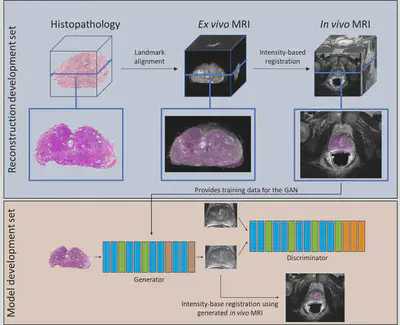ICARUS
Overview
An ever-increasing amount of treatment options is available to prostate cancer patients. Although this is a positive development, it also increases the complexity of selecting the right therapy for the individual patient. The fusion of in and ex vivo information streams, such as from radiology and pathology, offers a promising avenue for improved models of disease physiology and progression, and consequently, better strategies for treatment selection. However, to build accurate models, large sets of fused radiology/pathology data are needed, which have been impossible to obtain due to the time-consuming and expensive nature of acquiring such datasets.
In this project, we propose an artificial-intelligence-based platform that can automatically combine large archival sets of digitized histopathological slides and multi-parametric MRI (mp-MRI) and leverage them to build a disease model which will improve 1) identification of clinically significant prostate cancer, 2) selection of patients for active surveillance, and 3) predict lutetium-PSMA treatment success.

Tasks
This project encompasses five objectives: I) establish a collection of combined mp-MRI and digitized prostatectomy specimens from 1350 patients, II) build an automated reconstruction algorithm for the generation of 3D tissue volumes from 2D digitized histopathology slides, III) develop registration techniques for spatial alignment of ex vivo histopathology to in vivo mp-MRI, IV) learn mp-MRI / histopathology correlations using unique deep streaming generative models, and V) Evaluate the learned correlations for improved diagnostics, active surveillance, and lutetium-PSMA treatment selection.
The impact of the project will not just be improved diagnostic and treatment decisions for patients but can be the starting point of an entirely new field of cross-medical-specialty research; the developed platform can be leveraged for other cancer types and even non-oncological diseases.